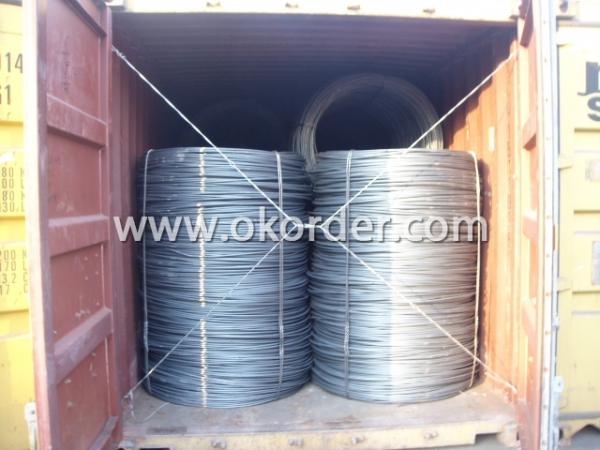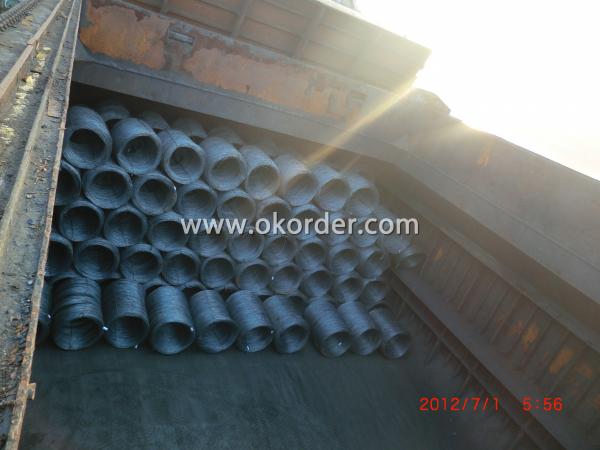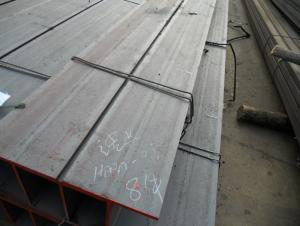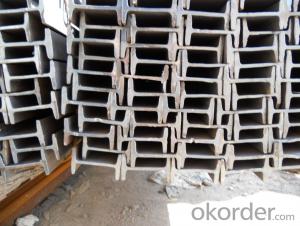HR Steel Wire Rod
- Loading Port:
- Tianjin
- Payment Terms:
- TT OR LC
- Min Order Qty:
- -
- Supply Capability:
- 200000 m.t./month
OKorder Service Pledge
OKorder Financial Service
You Might Also Like
Specifications of Hot Rolled Wire Rod:
Steel Grade: Q195/235, SAE1006-1018B Standard: ASTM, GB
Diameter: 5.5mm, 6.5mm, 7mm,8mm,9mm,10mm,12mm,14mm
Type: in coil, coil weight around 2MT Alloy or Not: Alloy
Technique: Hot Rolled Place of Origin: China Mainland
Surface: round, no twisted, light and smooth Brand Name: HSKY
Chemical Composition: (Please kindly find our chemistry of our material based on Q195、Q235A and Q235B as below for your information)
| Trademark | Rank | Chemical composition (quality score) % | ||||
| C | Si | Mn | S | P | ||
| ≤ | ≤ | ≤ | ||||
| Q195 | 0.06-0.12 | 0.30 | 0.25 | 0.050 | 0.045 | |
| Q235 | A | 0.14-0.22 | 0.30 | 0.30-0.65 | 0.050 | 0.045 |
| Q235 | B | 0.12-0.20 | 0.30 | 0.30-0.70 | 0.045 | 0.045 |
Usage and Applications of Hot Rolled Wire Rod:
After hot-rolled the products shaped into coil and delivery as finished product, including round, square, rectangular, hexagonal and so on. Since most of the products are round, it is generally called wire rod. Carbon steel wire rod is widely used in construction and manufacturing. Carbon steel wire rod is mainly used for reinforcement of reinforced concrete and welded structure or reprocessed (roberts , nail, etc.) materials, especially used to produce wire drawing, welding electrode, nails, spring, electronic, precise machinery parts and so on.
Packaging & Delivery of Hot Rolled Wire Rod:
Packaging Detail: products are packed in coil, each coil weight around 2 MT, and then shipped by container or bulk vessel
Delivery Detail: within 45 days after received deposit or LC.
Label: to be specified by customer, generally, each bundle has 1-2 labels
Trade terms: FOB, CFR, CIF
Hot Rolled Wire Rod in Container

Hot Rolled Wire Rod in Bulk Vessel

Note:
1. Our products are produced according to national standard (GB), if not, supply according to national standards (GB) or agreement as customer required.
2. Other Grade and Standard carbon steel wire rod we can supply:
Grade: H08A, 30MnSi, 62B-82B
Standard: AISI, BS, JIS, DIN
The Minimum Order Quantity of these products is high, and need to be confirmed.
3. We can not only supply carbon steel wire rod; if you need anything about building materials, please contact us.
4. Please send us your detail specifications when inquire. We will reply to you as soon as possible. We sincerely hope we can establish a long stable business relationship.
- Q:Can steel H-beams be used for supporting elevated walkways or platforms?
- Indeed, elevated walkways or platforms can be supported by steel H-beams. In construction, steel H-beams are frequently employed due to their robustness and endurance. Their exceptional load-bearing capacities make them well-suited for sustaining structures like walkways and platforms. The H-shaped configuration of these beams enables superior weight distribution and resistance against bending or twisting forces, guaranteeing stability and safety for elevated constructions. Moreover, steel H-beams can be conveniently fabricated and installed, rendering them a pragmatic selection for such purposes.
- Q:What are the different sizes of steel H-beams available in the market?
- The market offers a range of steel H-beams in various sizes, which may differ depending on the manufacturer and the project requirements. However, there are commonly found standard sizes. These sizes typically span from 100mm to 1,000mm in height, while their widths can vary between 50mm and 500mm. The length of the beams can also differ, with standard lengths typically falling within the range of 6 meters to 12 meters. Additionally, there are custom sizes available for more specific applications. To ascertain the precise sizes and specifications available in the market, it is advisable to consult with manufacturers or suppliers.
- Q:Can Steel H-Beams be used in museum or gallery construction?
- Yes, Steel H-Beams can be used in museum or gallery construction. Steel H-Beams are commonly used in construction due to their strength and durability. They provide structural support and can withstand heavy loads, making them suitable for large and open spaces like museums and galleries. Additionally, Steel H-Beams are versatile and can be fabricated to meet specific design requirements, allowing for unique architectural features. Their fire resistance properties also make them a safe choice for such buildings. Overall, Steel H-Beams are a popular choice in construction, including museum and gallery projects, due to their strength, versatility, and safety features.
- Q:What are the different types of steel used for manufacturing H-beams?
- There are several different types of steel that are commonly used for manufacturing H-beams. The selection of the steel type depends on various factors such as the required strength, durability, and cost-effectiveness for the specific application. 1. Carbon Steel: This is the most common type of steel used in H-beam manufacturing. It contains mostly iron and carbon, with small amounts of other elements. Carbon steel is known for its high strength and affordability, making it a popular choice for a wide range of applications. 2. Alloy Steel: Alloy steel is a type of steel that contains additional alloying elements such as chromium, nickel, or molybdenum. These elements enhance the steel's strength, hardness, and resistance to corrosion. Alloy steel H-beams are frequently used in heavy-duty construction projects or applications that require exceptional strength. 3. Stainless Steel: Stainless steel is a type of steel that contains a minimum of 10.5% chromium, which gives it excellent resistance to corrosion and staining. H-beams made from stainless steel are commonly used in applications where hygiene, durability, and aesthetic appeal are critical, such as in the food industry or architectural structures. 4. High-strength Low-alloy (HSLA) Steel: HSLA steel is a type of steel that provides high strength and improved toughness compared to standard carbon steel. It often contains small amounts of alloying elements such as vanadium, niobium, or titanium, which enhance its mechanical properties. HSLA steel H-beams are commonly used in applications that require high strength-to-weight ratio, such as bridges or heavy machinery. 5. Weathering Steel: Weathering steel, also known as Corten steel, is a type of steel that develops a protective layer of rust when exposed to the elements. This layer acts as a barrier against further corrosion and eliminates the need for painting or maintenance. Weathering steel H-beams are often utilized in outdoor structures like bridges or sculptures. It is essential to select the appropriate type of steel for manufacturing H-beams based on the specific requirements of the project, considering factors such as strength, durability, corrosion resistance, and cost-effectiveness.
- Q:Are Steel H-Beams resistant to termite or insect damage?
- Yes, Steel H-Beams are highly resistant to termite or insect damage. Unlike wood, steel does not provide a food source for termites or insects, making it an ideal material for structural components such as H-Beams.
- Q:Can steel H-beams be used in the construction of educational institutions or schools?
- Certainly! Steel H-beams are indeed applicable for the construction of educational institutions and schools. Their strength and durability make them a popular choice in the construction industry. These beams offer exceptional structural support, making them suitable for a wide range of purposes, including educational buildings. Within educational institutions, steel H-beams can be utilized in the construction of school buildings, gymnasiums, auditoriums, and other facilities. They possess the capacity to bear heavy loads such as floors, walls, and roofs, ensuring the safety and stability of the structure. Moreover, steel H-beams are resistant to fire and termites, and they have a long lifespan, making them a dependable option for educational construction projects.
- Q:What are the design considerations for steel H-beams in coastal areas?
- Some key design considerations for steel H-beams in coastal areas include corrosion resistance, durability against saltwater exposure, and high wind loads. The beams should be made from corrosion-resistant materials, such as stainless steel or galvanized steel, to prevent the deterioration caused by saltwater. Additionally, the design should account for the increased risk of corrosion due to the high salt content in the atmosphere. The beams should also be able to withstand the strong winds and potential storm surges commonly experienced in coastal regions. Proper anchoring and bracing techniques should be employed to ensure the structural integrity and stability of the beams in these challenging environmental conditions.
- Q:What does H steel.R represent?
- The latest H steel specifications range wide, medium and narrow flange H steel size, H- height, B- width, t1- web thickness, t2- flange thickness, r- rounded radius
- Q:Are steel H-beams suitable for modular construction?
- Yes, steel H-beams are suitable for modular construction. H-beams, also known as I-beams or W-beams, are widely used in the construction industry due to their high strength-to-weight ratio and versatility. They are especially suitable for modular construction, a process that involves fabricating building components off-site and assembling them at the construction site. Steel H-beams offer several advantages for modular construction. Firstly, their structural strength allows for the creation of large, open spaces without the need for excessive support columns or walls. This makes them ideal for constructing modular buildings that require flexibility in interior layout and design. Additionally, H-beams are lightweight compared to their load-bearing capacity, making them easier to transport and handle during the modular construction process. Their prefabricated nature also reduces the time and labor required on-site, resulting in faster construction timelines and cost savings. Furthermore, steel H-beams have excellent durability and resistance to environmental factors such as fire, corrosion, and pests. This ensures that modular buildings constructed using H-beams have a longer lifespan and require minimal maintenance. Lastly, steel H-beams can be easily recycled, making them a sustainable choice for modular construction. Their high scrap value and recyclability contribute to reducing the environmental impact of construction projects. In conclusion, steel H-beams are highly suitable for modular construction due to their structural strength, lightweight nature, durability, and sustainability. They allow for the creation of flexible and spacious modular buildings while reducing construction time and costs.
- Q:What are the considerations when designing for corrosion protection of Steel H-Beams?
- When designing for corrosion protection of Steel H-Beams, several considerations come into play. First and foremost, the environmental conditions in which the beams will be installed need to be evaluated. Factors such as humidity, temperature variations, and exposure to corrosive substances like saltwater or chemicals can greatly impact the corrosion resistance requirements. Another crucial consideration is the choice of coating or surface treatment. Various options such as galvanizing, epoxy coatings, or powder coatings offer different levels of protection and durability. The selection should be based on the specific project requirements, anticipated exposure conditions, and budget constraints. Furthermore, the design should incorporate proper drainage and ventilation systems to prevent the accumulation of moisture, which can accelerate corrosion. This may involve the inclusion of weep holes, gaps, or coatings that allow for moisture escape. Maintenance and inspection protocols should also be established to ensure the long-term effectiveness of the corrosion protection measures. Regular inspections, cleaning, and touch-up coating applications may be necessary to mitigate any potential damage or degradation. Ultimately, designing for corrosion protection of Steel H-Beams requires a comprehensive understanding of the project's environmental conditions, suitable coating options, proper drainage, and maintenance protocols to ensure the longevity and structural integrity of the beams.
1. Manufacturer Overview |
|
|---|---|
| Location | |
| Year Established | |
| Annual Output Value | |
| Main Markets | |
| Company Certifications | |
2. Manufacturer Certificates |
|
|---|---|
| a) Certification Name | |
| Range | |
| Reference | |
| Validity Period | |
3. Manufacturer Capability |
|
|---|---|
| a)Trade Capacity | |
| Nearest Port | |
| Export Percentage | |
| No.of Employees in Trade Department | |
| Language Spoken: | |
| b)Factory Information | |
| Factory Size: | |
| No. of Production Lines | |
| Contract Manufacturing | |
| Product Price Range | |
Send your message to us
HR Steel Wire Rod
- Loading Port:
- Tianjin
- Payment Terms:
- TT OR LC
- Min Order Qty:
- -
- Supply Capability:
- 200000 m.t./month
OKorder Service Pledge
OKorder Financial Service
Similar products
New products
Hot products
Related keywords



























